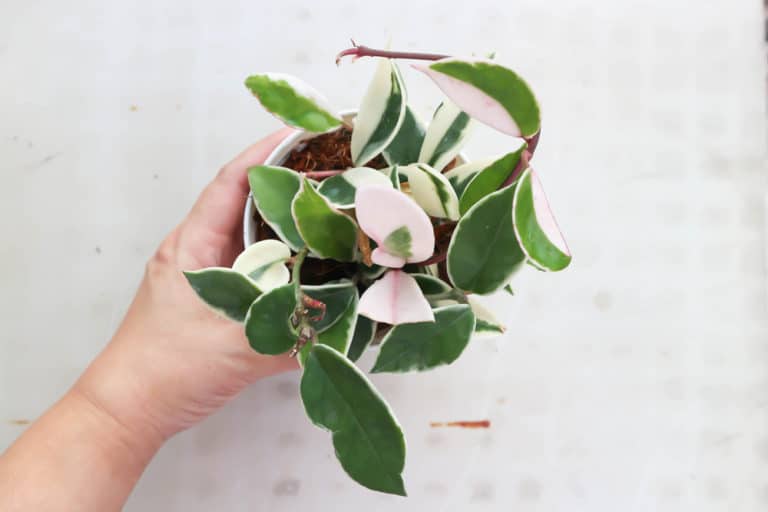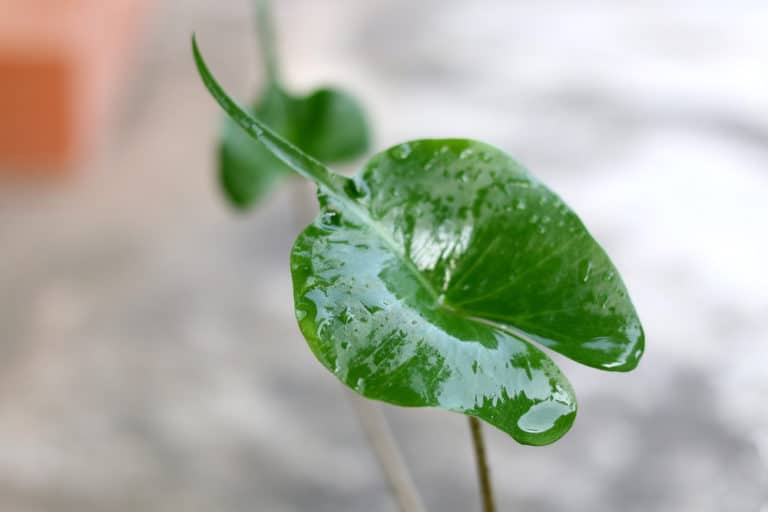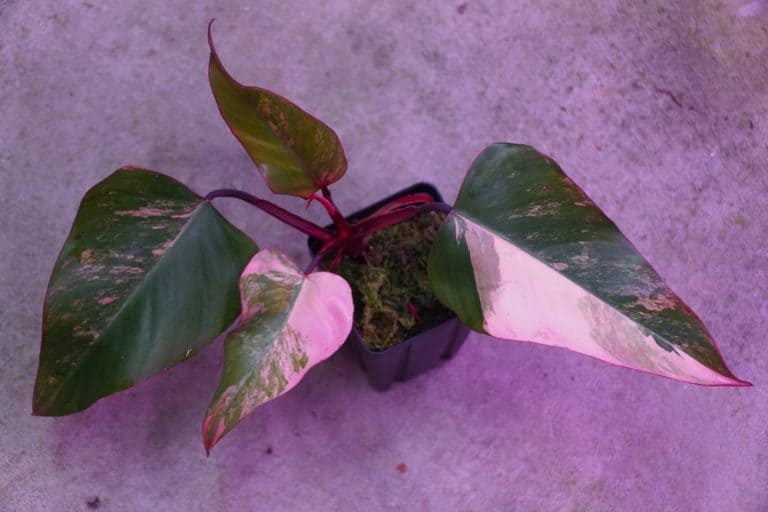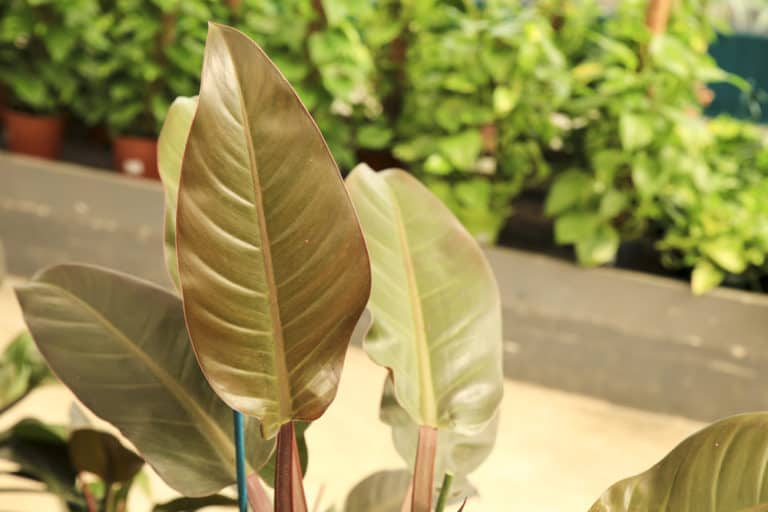Pinguicula ‘Mexican Butterwort’ Care Guide (2024)
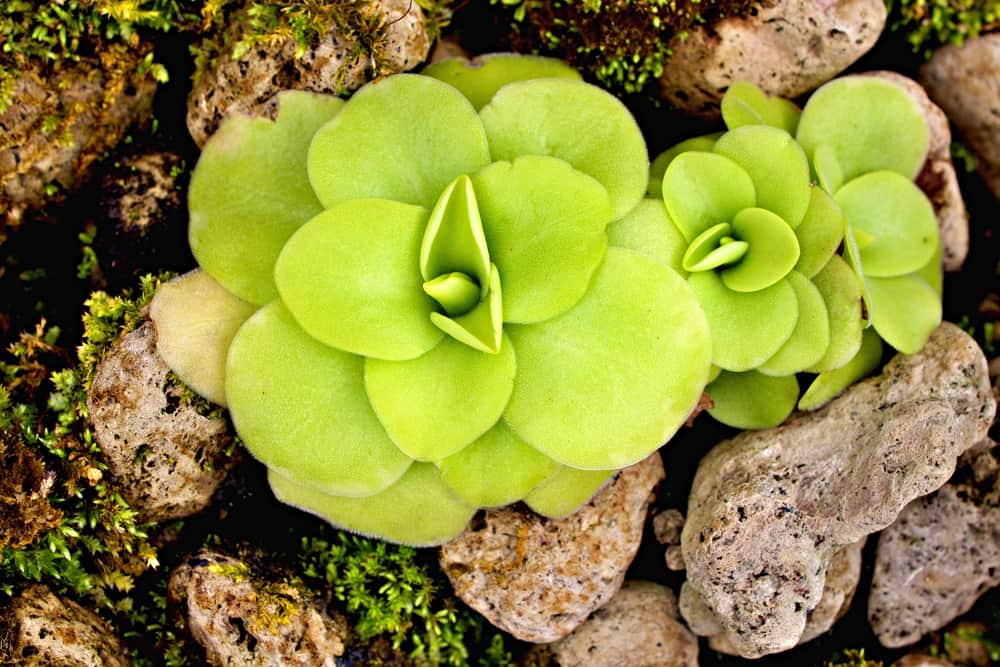
Pinguicula plants are carnivorous plants that can be found across the northern hemisphere and down into Central and South America.
There are many different cultivars of Mexican butterwort, but they all share basic characteristics.
Using their sticky leaves, they trap and eat bugs, making them an intriguing and useful addition to your indoor garden.
| Scientific Name | Pinguicula |
| Common Name | Mexican Butterwort |
| Light | Bright, indirect light |
| Watering | Water if the surface of the soil is dry |
| Temperature | 55 to 85ºF (13 to 29ºC) |
| Hardiness Zone | 10 to 11 |
| Humidity | 70% |
| Soil Type | Sandy, quick-draining |
| Soil pH | 7 to 8 (slightly alkaline) |
| Fertilizing | Not recommended |
| Repotting | Every 2 years |
| Pruning | Beginning of the growing season |
| Propagation | Leaf cuttings |
| Toxicity | Not toxic to humans and pets |
| Mature Size | 1 inch to 12 inches as a houseplant |
| Bloom Time | Spring |
What’s Unique About Mexican butterwort?
While the Pinguicula family of carnivorous plants are native to much of the Northern Hemisphere, Central and South America are home to many different species.
The Mexican butterwort plant is not one single cultivar. In fact, in just the last few decades dozens of new species have been found across Central America..
The Latin name Pinguicula means “little greasy one”, and the Mexican butterwort plants live up to the family name, as well as its common one. If you touch a butterwort leaf, it will feel greasy.
Growing Mexican butterwort has some challenges unique to these plants, but watching them grow and change with the seasons is fascinating.
And let’s not forget their primary purpose in life— catching and eating insects.
Mexican butterwort Care
While there are many different Pinguicula species in Central America, Mexican butterwort plant care is basically the same for all of them.
In the subtropical zones where Mexican butterwort originates, it is used to hot, wet summers and cooler, drier winters.
Your Pinguicula care should replicate this to keep this carnivorous plant happy.
Light
While the sun is bright in Mexico, the Mexican butterwort plant is not usually exposed to the full sun.
Mexican butterwort light requirements are for bright, indirect light, or between 10,000 to 20,000 lux.
LED lights are a good way to provide consistent Pinguicula light needs if you don’t have enough natural light. Hang them 12 inches away from the plants, and aim for 14 hours light in summer and 10 hours in winter..
However, your Mexican butterwort plant will also be quite happy on an east-facing window ledge.
In a room with a south or west exposure, you need to find a spot out of the full afternoon sun.
Watering
Mexican butterwort watering should vary with the seasons.
In its native habitat, Mexican butterwort plants are used to wet summers and dry winters.
In spring and summer, water Pinguicula whenever the soil surface dries out. Always water from below so that the leaves will not get wet.
In fact, the best thing to do in summer is to leave a half inch of water in the tray at all times to make sure the soil stays moist.
In winter, the Mexican butterwort plant’s watering needs change dramatically. As the plant enters its dormant phase, you should let the soil dry out almost completely between waterings.
Always use distilled or rainwater for your Mexican butterwort plant, as the minerals and salts in other waters will damage the plants.
Temperature
Just like its watering schedule, the Mexican butterwort temperature range varies with the season.
In spring and summer, the best temperature for Pinguicula is between 68 to 85°F (20 to 29°C). Moving your pots outside for the summer would really give them a boost.
However, in fall and winter, they prefer a range from 41 to 50°F (5 to 10°C) when they go dormant. You should find a location such as an unheated garage or sunroom for those months.
Some species of Mexican butterwort have a greater temperature tolerance and hardiness, and are able to survive light frosts or temperatures as low as 20°F (-7°C) for several nights.
Humidity
The Mexican butterwort humidity requirements vary from species to species, depending on where they evolved.
However, the ideal humidity for Pinguicula is usually fairly high, ranging up to 70%.
Usually a Mexican butterwort will be perfectly content at a humidity level as low as 40%, which is not out of line for a modern home.
Summer humidity can usually be boosted by leaving a half inch of water in the pot tray or saucer at all times.
Just grouping your potted plants together can help provide some extra humidity.
You can also use a small diffuser or humidifier to maintain a consistently humid microclimate for your Mexican butterwort.
Soil
While some carnivorous plants grow in peat bogs, Mexican butterwort plants grow out of limestone boulders or on stony hillsides.
Thus, Mexican butterwort soil should be very sandy and loose. The best pH level for Pinguicula is 7 to 8, or slightly alkaline.
You can make a custom soil for Pinguicula with equal parts of peat moss, coarse sand, and perlite or pumice. If you can find it, you can substitute ground bark for the peat.
You can also use a commercial potting soil mix with extra perlite.
If you are concerned that the soil may be too acidic, mix in some dolomitic lime to make it more sweet.
Fertilizer
When it comes to Mexican butterwort fertilizer, most experts say don’t!
Using fertilizer for Pinguicula can kill the plant if you don’t know what you’re doing.
As well, Mexican butterwort usually has no trouble feeding itself by catching and eating insects.
If you are worried that your Mexican butterwort isn’t getting enough bugs, you can lay a couple of dried bloodworms on the leaves in summer every 2 to 3 weeks.
However, you can use a very diluted kelp solution with a fertilizer ratio of 16-16-16 to provide occasional nutrients in spring and summer. Apply it to the leaves, not the soil.
Your Mexican butterwort will not need any feeding of any sort in fall and winter.
Potting & Repotting
Mexican butterwort repotting should be done every 2 years in early spring, just as it’s emerging from its dormant period.
The container does not need to be deep, as Mexican butterwort has a shallow root system. Plastic or clay pots will both work well.
You do want to make sure that the new pot has good drainage holes, especially since watering from below is recommended.
Go up a pot size when repotting Pinguicula, but never more than that.
Consider planting different Mexican butterwort species together in the same large pot to create a vibrant look.
Always use fresh potting mix.
Pruning
You really won’t have to do much Mexican butterwort pruning at all.
At most, you should always trim any dead or yellowing leaves when they occur.
This will certainly happen in the fall. That’s when Mexican butterwort goes into its dormant phase and the large carnivorous leaves die off to be replaced with small succulent leaves.
Never leave any plant debris on the soil surface; not only can it encourage disease, but it might also attract the wrong sort of pests, such as slugs.
When cutting Pinguicula, always use sharp, sterilized scissors to prevent the spread of disease and minimize damage to the plant.
Propagation
Mexican butterwort propagation can be done by division, leaf pullings, and seed.
The easiest way to propagate Pinguicula is by division. After flowering your Mexican butterwort may split into different rosettes.
Remove the root ball from its pot and gently separate the rosettes, using a sharp knife if necessary.
Many growers prefer propagation with seeds. You can sow seeds of Mexican butterwort on the surface of a damp soil mix.
Cover the pot with a plastic bag to maintain humidity, and they should germinate in 1 or 2 months.
The final method of propagation is by leaf pulling. In spring, pull off older leaves, and set them atop a moist growing medium.
Keep them moist, and soon you should see strong roots and new leaves growing from the leaf base.
Common Problems of Mexican butterwort
Mexican butterwort problems are usually the consequence of not providing these exotic carnivores with suitable growing conditions.
Problems with Pinguicula can include pests and diseases, as well as some issues with watering and temperature.
As long as the leaves are healthy and glistening, (and covered with little bugs!) everything should be fine.
Pests
Considering that Pinguicula plants are carnivores that trap and eat bugs, it’s hard to believe that they might be susceptible to insect attack.
However, there are a few Mexican butterwort pests to watch out for.
While some of the larger Mexican butterwort species can trap aphids, smaller species are not as fortunate.
On those, the aphids head for the non-sticky areas, such as under new leaves.
While slugs can be a problem on Mexican butterwort plants, they don’t usually do enough damage to kill a plant.
You can spray plants with pyrethrin, or set a flea collar nearby to deter the aphids and slugs.
Fungus gnat larvae can attack the roots of your Mexican butterwort. You may need to remove all of the old soil and replant in a fresh, uncontaminated mix.
Diseases
Mexican butterwort diseases can be sudden and catastrophic, so you should keep an eye on your Pinguicula for any signs of trouble.
Browning heart disease is probably the most common Mexican butterwort disease. In spring and summer, you may notice that your plant has stopped growing and its leaves have lost their stickiness.
This is a fungal disease accompanied by a nematode infestation. It’s more likely if you water your Mexican butterwort soil from the top.
While you can try using fungicides and nematicides, your best hope is probably isolating the plants and keeping them completely dry. You may see a recovery after a few weeks.
Growing Problems
Other growing problems are just a symptom of poor growing conditions, and by improving those you sometimes can save your sick plant.
Rosette edge-to-center death is a condition that occurs in early spring when plants have been brought back from their cool winter dormancy location to a warmer spot.
It starts with browning tips, and then the browning rapidly spreads right to the center of the rosette.
By then it’s too late to prevent the process, which is caused by the thermal shock of too fast a switch to a warm environment.
Hole formation is the sudden development of a hole in the leaf, which soon spreads and destroys the entire leaf. It’s caused by a calcium and potassium deficiency in the soil. Once you’ve restored those elements, your Mexican butterwort should recover.
Toxicity of Mexican butterwort
Pinguicula may mean death to fungus gnats, but it’s not at all toxic to humans and animals.
This lack of toxicity, along with its fascinating growth habits and ability to trap bugs, can make it an interesting plant to share with children in your home.
However, you should take the normal precautions when growing any plants in a home with pets and children.
For Humans
Mexican butterwort is not at all toxic to humans.
In fact, other species of butterwort native to temperate zones have been used by Scandinavians for centuries to curdle milk for a fermented drink similar to buttermilk.
However, while you can encourage children to observe these interesting carnivorous plants, it’s best that they don’t get their hands on them.
Especially if you are using insecticides such as flea collars, or fungicides, you don’t want to expose your children to those chemicals.
As well, while Mexican butterwort is safe, many other houseplants are not, and young kids can’t necessarily tell the difference.
For Pets
Mexican butterwort is not toxic to pets, but that doesn’t mean that you want your cat or dog nibbling on your precious Pinguicula.
In the first place, it wouldn’t take much for a little butterwort plant to get destroyed by a rambunctious dog or determined cat.
As well, even if it won’t mean a trip to the veterinarian, eating too much of your Mexican butterwort can cause some gastrointestinal issues for your pet.
Cats and dogs are, just like your Mexican butterwort, carnivores. Their digestive systems are not equipped to handle much in the way of plant material.
As a result, they can end up with vomiting and diarrhea for a few hours, which won’t be much fun for anyone.
Mexican butterwort Appearance
The important thing to understand about the Mexican butterwort appearance is that there’s a lot of variety between the more than 40 species that have been discovered.
Some are large, some are tiny, but they share a few key characteristics. They have leaves that trap and digest bugs, and they send up vibrant flowers in spring and summer.
Foliage
The foliage of Mexican butterwort is heterophyllous, meaning that it has more than one form of leaf on the same plant.
In spring and summer Mexican butterwort leaves are flat, usually with edges that curve up, forming a slightly cupped shape.
The leaves have short hairs covered in a sticky substance that makes the leaves glisten in the sun, and traps bugs that get too close.
Then, sessile glands secrete a mixture of acids and enzymes that digest the creatures and feed the plant.
In fall and winter, these leaves are replaced with smaller, succulent leaves for the dormant season.
Flowering
The Pinguicula flower is one of the outstanding features of these fascinating plants.
Mexican butterwort flowering occurs in spring and early summer at the start of its growing season.
When your Mexican butterwort is blooming, it will have tall, slender stalks shooting up out of the center of the rosettes. The flowers have 5 petals, but the color and arrangement of those petals depends on the species. Colors range from red to purple to yellow and white.
In the wild, Mexican butterwort flowers are pollinated by hummingbirds, but if you are growing yours indoors you will have to do it yourself if you want seeds for propagation.
Size and Growth
The size of Mexican butterwort depends on the individual species.
Pinguicula gigantea, for instance, can reach a diameter of 1 foot, while the Pinguicula laueana tops out at 1 inch across.
Mexican butterwort plants grow in tight rosettes that expand in size. However, the dormant succulent form is significantly smaller than in the active growing season.
They have a fairly slow growth rate and can take 5 to 10 years to reach their full size.
They can, however, be expected to propagate new rosettes as they grow, giving you lots of opportunities to pot up new plants and expand your collection.
Mexican butterwort Fragrance
Mexican butterwort fragrance is not really a part of the attraction of these plants.
The scent of the leaves is not particularly pleasant, as the carnivorous foliage exudes a musty smell which insects like fungus gnats are attracted to.
However, it’s not a strong smell so it should not bother you unless you’re right next to the Mexican butterwort.
Most people do not report any scent associated with the flowers, although they may occasionally exude a very slight floral fragrance. They use their colors and nectar to attract pollinators instead.
It’s best to assume that these lovely flowers will be a visual pleasure only.
Suggested Uses for Mexican butterwort
When planning where to locate your Mexican butterwort indoors, you will want to consider not just the looks but the utility of this carnivorous plant.
If you have trouble with drain flies in your bathroom, keeping your Mexican butterwort on a sunny window ledge is an ideal solution.
You may also sit one on your kitchen counter if you’re plagued with fruit flies.
If your indoor houseplants have an infestation of fungus gnats or whiteflies, that won’t last long with a few Mexican butterwort plants in their midst.
You can also move your Mexican butterwort plants outdoors in hot weather.
FAQ
What is Mexican butterwort?
Mexican butterwort is a common name for dozens of species of carnivorous plants in the Pinguicula family that are native to Mexico and Central America.
How to identify Mexican butterwort?
Mexican butterwort plants have flat leaves with edges that curve up slightly, with sticky hairs that glisten in the light. They grow in tight rosettes.
How to care for Mexican butterwort?
Mexican butterwort should be grown in bright, indirect light in a warm, humid environment and kept well watered in their growing season. They should not be fertilized.
How to grow Mexican butterwort indoors?
Mexican butterwort can be grown as a container plant in a warm space with fairly high humidity in spring and summer, and then moved to a cooler spot in winter.
How to grow Mexican butterwort outdoors?
Mexican butterwort can be grown outdoors in the ground year-round in zones 10 to 11, or moved outside in pots in summer in temperate zones.
How fast does Mexican butterwort grow?
Mexican butterwort has a moderate to slow growth rate and may take 5 to 10 years to reach its full size when grown as a potted plant.
How tall does Mexican butterwort grow?
The size of a Mexican butterwort plant varies depending on the species. Some stay very small and short, while others can have a spread of a foot. They are usually low-growing.
How to make Mexican butterwort grow faster?
Mexican butterwort will grow its fastest when grown in a warm, humid environment with consistent water and bright, indirect light. Do not use fertilizer to spur growth.
How to stake Mexican butterwort?
Mexican butterwort is a low-growing plant that maintains a tight rosette shape. It does not need to be staked and is not suitable as a hanging plant.
How to pot Mexican butterwort?
Mexican butterwort should be planted in a loose, sandy soil mix, in a shallow pot plastic or glazed pot with good drainage holes to permit bottom watering.
How to revive Mexican butterwort?
If your Mexican butterwort leaves are developing holes, it is probably suffering from a calcium and potassium deficiency. Adding those elements to the soil should revive it.
Why is my Mexican butterwort dying?
Your Mexican butterwort may have Rosette edge-to-center death, which is caused by moving it too abruptly from a cool to warm location. There is no cure.
Why is my Mexican butterwort drooping?
Your Mexican butterwort may simply be going through its normal seasonal cycle when the carnivorous leaves wilt and die, to be replaced with succulent leaves for the winter.
How cold can Mexican butterwort tolerate?
Mexican butterwort prefers 68 to 85°F (20 to 29°C) in summer, and 41 to 50°F (5 to 10°C) in winter. Some species can handle temperatures as low as 20°F (-7°C).
How to get rid of pests on Mexican butterwort?
Mexican butterwort usually kills its own pests, but you may have to control aphids with an organic spray or flea collar, and change the soil to get rid of fungus gnat larvae.
Is Mexican butterwort toxic to cats?
No, Mexican butterwort plants are not toxic to cats. However, cats are carnivores and cannot digest too much plant material, so they should not eat it.
Is Mexican butterwort toxic to dogs?
No, Mexican butterwort plants are not toxic to dogs. However, since they have trouble digesting vegetable matter, they may develop vomiting and diarrhea after ingesting it.
Is Mexican butterwort toxic to children?
No, Mexican butterwort plants are not toxic to children, but they should not be exposed to any chemicals that you may have used on the plant.
Is Mexican butterwort toxic to humans?
No, Mexican butterwort plants are not toxic to humans, so you do not have to take any precautions such as wearing gloves when handling the plant.
Does Mexican butterwort have a scent?
Mexican butterwort leaves have a musty, fungal odor to attract insects, but it’s not very strong. If the flowers have any scent at all it is faint and fleeting.


